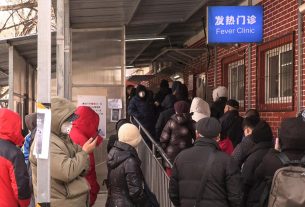twIn an emotional social-media video posted Dec. 8, singer Celine Dion informed fans that she has been diagnosed with a rare neurological disease called stiff person syndrome. A diagnosis wasn’t easy or straightforward. “I’ve been dealing with problems with my health for a long time…we now know this is what’s been causing all of the spasms that I’ve been having,” said Dion, who is 54.
Here’s what to know about the condition and what it feels like.
What is stiff person syndrome?
According to the National Institute of Neurological Disorders and Stroke, stiff person syndrome has similarities to autoimmune disease, in which the body’s immune system attacks its own cells. The condition is linked to higher levels of antibodies that bind to an enzyme called glutamic acid decarboxylase (GAD), which works on a brain chemical, GABA, responsible for inhibiting activity in the central nervous system. GABA is normally in balance with another chemical that stimulates nerves, which, in the case of muscles, makes them contract.
“Something in the software goes wrong, and the inhibitory system starts to malfunction,” says Dr. Avi Almozlino, chief of neurology at Newton Wellesley Hospital, part of the Massachusetts General Hospital-Brigham system. “The inhibitory signals become weaker and weaker, and the excitatory signals start to take over, contracting the muscles uncontrollably.” People with the condition often experience muscle spasms in the trunk, arms, or legs and become more sensitive to noise and touch. Emotional triggers, including stress, can worsen the muscle spasms. Those episodes can make it difficult to walk or move to perform basic daily tasks. In her video, Dion said she isn’t able to control her vocal cords and sing in the way she once did, and therefore postponed upcoming tour dates in Europe.
How rare is stiff person syndrome?
Only about one in a million people gets stiff person syndrome, and the disease affects twice as many women as men. Many people, like Dion, spend months or years trying to find the reason for their spasms, since the symptoms can mimic some other autoimmune disorders.
One of the those patients is Maureen Materna, a 74-year old from Cleveland, Ohio who has been living with the condition since 2011. Like Dion’s diagnosis, it took doctors a while to reach hers. “I was always very active—I walked, biked and exercised, and was one of those people that does 20 millions things at one time,” Materna says. Then, she started getting intense cramps in her feet and legs that wouldn’t go away. The episodes would last about 45 minutes and leave her screaming in pain. But otherwise, she was healthy.
After a visit to the emergency room, doctors gave her a Valium drip to address the pain, which helped, but she still didn’t know why she was experiencing spasms. Two years and about 20 doctors later, a neuromuscular specialist finally diagnosed her with stiff person syndrome, based on her symptoms and the fact that Valium was the only intervention that seemed to alleviate some of the pain. “To this day when I see doctors for something else and they see that I have stiff person syndrome, I cannot tell you how many [of them] have said, ‘What is that? I’ve never heard of it.’”
What does it feel like to have stiff person syndrome?
Materna can’t sit for long periods of time, so even if she’s watching television, she has to get up every 20 minutes or so. Her muscle-locking means she can’t accompany her husband and their grandchildren to shows, where she would have to sit for lengthy periods of time. Until last year, bedroom slippers were the only footwear that made her feet comfortable. She walks every day, to keep herself active, but it’s a challenge. “It feels like I’m walking on broken glass,” she says. “But I’m not the type to lay in bed. I like to see my neighbors and distract myself and kind of forget that the pain is there.”
What causes stiff person syndrome?
While it’s not clear what triggers the syndrome in people who don’t show signs of immune system disorders beforehand, one theory is that stiff person syndrome could be the immune system’s very early response to cancer. “I’ve had some patients who initially presented with stiff person syndrome, and one to two years later, developed cancer,” says Dr. Robert Wilson, a neurologist at Cleveland Clinic and Materna’s physician. “The body may be sensing early cancer and generates an immune response to those early cancer cells with antibodies that cross react with the nervous system. These patients get their cancer treated and do improve.” But there are no definitive studies yet confirming this potential cause of the syndrome.
Others develop stiff person syndrome after different health issues, including bouts of viral infections or stressful experiences that may trigger the immune system in a dysfunctional way. “It needs to be studied more why some people develop stiff person syndrome and not others,” says Wilson.
Can people recover from stiff person syndrome?
Currently, the treatments for the condition include muscle relaxants and anti-convulsant medications, which can alleviate some of the symptoms of the condition, as well as IV antibody treatments that try to reset the immune system to dial down its attack on the body’s own cells. The monoclonal antibody medication rituximab (Rituxan), which is prescribed to treat certain autoimmune diseases and cancers, can also help. But people can have varying responses to these therapies, says Wilson. “Some patients are rapid responders after a few treatments—they get their immune systems rebooted and recalibrated. And there are others who don’t respond as well, so we focus on symptomatic relief, which can also help them from getting worse.”
Materna tried getting infusions of an immunoglobulin, IgG, which helps to bolster the immune system, but the treatment didn’t help her significantly, and she stopped after about six years. She also tried plasmaphoresis, which involves regular removal and cleansing of plasma to remove the abnormal antibodies attacking the body’s immune cells. She developed a blood clot from the port required for the procedure and couldn’t continue. Next, Materna tried ketamine infusions to help with headaches, but those didn’t improve her symptoms either. She now takes Valium four times a day for pain, as well as a muscle relaxer, and does deep breathing exercises and meditation.
Each time she visits her doctor, Materna and her husband ask if there are any new treatments she can try, and the answer so far has been no. But she’s hopeful that with Dion’s diagnosis,more attention will be paid to the rare disease. “Maybe with her having it, scientists will start researching it more,” she says. “It’s a hard disease.”
More Must-Reads From TIME



